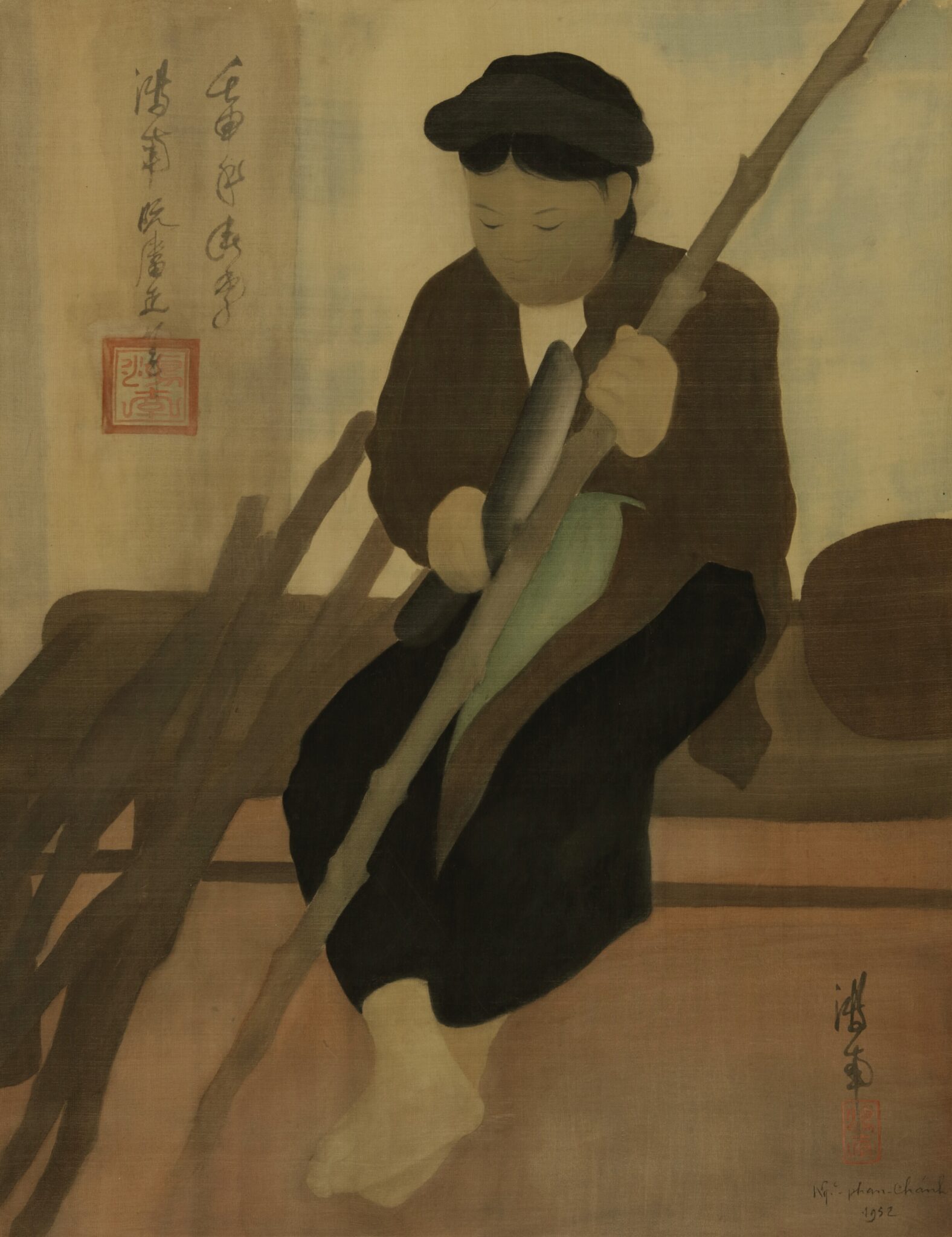
Nguyen Phan Chanh (Vietnam, 1892-1984)
La Marchande de canne à sucre (The Sugarcane Cutter)
inscribed in Chinese (upper left); signed, inscribed in Chinese and dated ‘Ng. phan. chanh Hong Nan 1932’ (lower right); exhibition label affixed (on the reverse)
ink and gouache on silk laid on paper
60 x 50.5 cm. (23 5/8 x 19 7/8 in.)
Painted in 1932
two seals of the artist
Provenance
Pierre Le Tan Collection
Nick Scheeres Collection (acquired from the above)
Private Collection, Europe (acquired from the above by the present owner)
Exhibited
Napoli, Seconda Mostra Internazionale d'Arte Coloniale, 1934
Paris, Pavillon des Arts, La Maison de la Wallonie, L'Aventure de L'Art Moderne au Viet Nam Paris-Hanoi-Saigon, March - May 1998
Price realised HKD 3,528,000 at Christie's Hong Kong, 26 May 2022

NGUYEN PHAN CHANH, 1932, "THE SUGARCANE CUTTER" OR THE SERENITY OF TRUTH
The Sugarcane Cutter was painted during Nguyen Phan Chanh’s exceptional period of creation extending from 1929 to 1933.
In 1932, Nguyen Phan Chanh was an artist already widely recognized for his talent.
The previous year, at the International Colonial Exhibition in Paris, the entire Indochina School of Fine Arts, under the tutelage of its founder Victor Tardieu, attracted a large and diverse audience, not only French but international. The Vietnamese artistic style was forming its distinctive identity. Moreover, a new brand of collectors, far from the usual circles of Hanoi, emerged. In the Paris of the 1930s, when everyone who matters -- artists, schools of thought, museums, galleries, magazines, etc.-- is vocal, the reception was impressive. With the art on offer being abundant, scrutinized, judged, a polite and distant response was to be expected. But to the contrary, the interest was there and the media took notice. "L'Illustration", one of the world’s largest media outlets at the time, in a sumptuous special Christmas issue in 1932, devoted a laudatory article - written by Jean Tardieu, Victor's son - to Vietnamese painting, which featured four Vietnamese works of art, all Nguyen Phan Chanh’s works on silk. The newspaper also presents the happy collectors-owners. Thus, the following works were illustrated: "The Witch" belonging to Pierre Massé, "The Young Girl Washing Vegetables" by Dr. Montel, "The Child with a Bird" by Dr. Morax. Massé was a prominent scientist, Morax a friend of Alexandre Yersin, a great ophthalmologist, Montel a great leprosy specialist and a benefactor. They were erudite, altruistic individuals, enthusiastic about Nguyen Phan Chanh's subtle art and who took over from the senior resident of Tonkin, Auguste Tholance, and his wife Guglielma, the painter's first admirers in Hanoi.
Indeed, in 1932, Nguyen Phan Chanh was a recognized artist by prominent collectors. He also successfully convinced the very hard-to-please Parisian critics.
Yes nothing is harder than confirming one’s success. The painter who paints slowly, thus provides another masterpiece, "The Sugarcane Cutter ".
The work is particularly well documented. It appears in the catalogue (Catalogue I Pitture su seta n. 423) of the 1934-1935 Seconda Mostra Internazionale d’Arte Coloniale of Naples, Italy, where the AGINDO ("Agence économique de l'Indochine" or Indochina Economic Agency) included it in its continued promotion of Vietnamese art.
On the back, a label reads the location, the title and the selling price : 1,500 French Francs in 1934 (collectors and investors will appreciate this).
The Sugarcane Cutter blends the painter’s classical characteristics while displaying important novelties.
Nguyen Phan Chanh, with his superb handwriting, continued to date and sign and to affix his seal in Chinese: at the top left, from left to right, the first vertical line gives us the year of the monkey, the second vertical line reads from top to bottom "Hong Nan" and "Nguyen Phan Chanh". But at the bottom right, while "Hong Nan" in script and seal are still in Chinese, the painter - and this is a novelty - also signs in qu?c ng? (not only in Roman letters as shown by the presence of diacritical marks) and dates "1932". This must be seen as a desire to better inform a non-Chinese audience.
The traditional silk mounting is preserved with the large rectangle at the top of the painted work opposite the small rectangle at the bottom, but the artist and previous owner Pierre Le Tan (Le Pho's son) had chosen to replace the dark Japanese lacquer of the traditional Gadin frame with a gold one that illuminates the painting by diffracting light.
Nguyen Phan Chanh retains his traditional geometric construction of line / triangle / circle / sphere, but this work is traversed by an abundance of lines (the sugar canes that stripe the composition), with more verticality (the lower limbs) that contrasts with the horizontality. There are fewer circles than usual, just the spherical box. The large rectangular table spreads across the work. The triangle of black ink (headdress and pants) is narrow. It is echoed by inverted triangles of flesh (face, hands and feet).
The traditional solid fields of brown is very successful, creating vibrating colour blocs. Purity as a manifesto.
Humility and strength.
Nguyen Phan Chanh distills his work to the quintessential: a character, a gesture, a writing. The eye is set on the gesture, worthy and beautiful. Concentration is action. The beauty of a gesture not a posture.
We are reminded here that Nguyen Phan Chanh is not only a painter and a poet, but also an ethnologist as he does not forget the detail of the "lá dong", a large leaf used as a practical tool by the merchant to protect her from possible projections from the cut.
The artist was by then 40 years old, he knew well that the world he did not choose is also a world that did not choose him.
In this sumptuous work, Nguyen Phan Chanh convinces us that while there is an epicureanism of simplicity, there is also a serenity of truth.
Jean-François Hubert
Senior Expert, Vietnamese art










